 Electrifying
the country Electrifying
the country |
Cambodia's infrastructure, which was almost completely
destroyed after more than 20 years of warfare,
civil strife and neglect, is slowly being restored.
Cambodia's public utilities are unreliable, expensive,
and cover only the major cities. There is tremendous
demand in Cambodia for diesel generators for use
as back up power, on-site industrial power plants,
and power generation in rural areas not served
by public utilities. Natural gas is not currently
economical in Cambodia.
Electricity grid exists, and only 12% of the
total population has access to electricity, with
only about 7 percent of the rural population having
access to a reliable electricity supply. Another
45 percent has less dependable battery-powered
electricity.
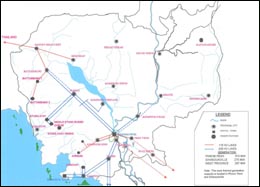
In Cambodia, electricity is generated in 22 isolated
systems, mostly from diesel generators. In 2000,
the total installed capacity of electricity generation
in Cambodia was 145 MW. As a result of the small
size of generation units (300 kW to 5 MW unit
size), dependence on oil-based generation, and
large distribution losses, the unit cost of electricity
in Cambodia is among the highest in the region.
Electricity sales increased from 311,508 MWH in
1999 to 355,790 MWH in 2000. Demand for power
in Cambodia as estimated at 125 MW in 1998 and
is expected to increase to 800 MW by 2016.
The minister's inviting message is clear "In
the power sector we would like to invite investors
to come develop our hydropower resources. This
is a very good opportunity, once we have linked
our network with the neighboring countries, we
can even sell the excess of power to them. The
GMS countries have signed the Inter-governmental
Agreement for Power Trade. H.E.
Ith Praing, Secretary of State at the Ministry
of Industry, Energy and Mines, concludes.
Cambodia is currently buying electricity for Poipet
town from Anco, an international engineering and
energy company that possess a transformer just
across the border in Sa Kaeo, Thailand. The project
cost $3 million, and also plans to supply Siem
Reap and Battambang in projects that cost upward
of $13 million. Thai company EGCO announced in
2001 that it would also bid on selling electricity
to these same Cambodian towns beginning in 2003.
Early last year, National Thai Electricity Company
EGAT finalized a Contract to supply 30MW of electricity
to western Cambodia.
Similarly, Cambodia signed agreements in 1999
and 2000 to buy electricity from Vietnam, a five-year,
$20 million venture that was supposed to begin
in 2001 with partial funding from the World Bank.
To supply the energy, Vietnam was to build a series
of transformers and power lines the stretched
from Can Tho in the Mekong Delta west into Takeo,
Cambodia. However, the project has yet to be completed.
Other cooperation with Vietnam are: (i) the importation
of power to supply communities close to the border
in the provinces of Svay Rieng, Takeo, Prey Veng,
Kandal and Kampot and (ii) a Feasibility Study
on the Interconnection between the two national
grids at high voltage.
 The power
sector strategy The power
sector strategy |
The Royal Government of Cambodia formulated policy
to provide adequate energy throughout Cambodia
at reasonable and affordable price and is determined
to take accelerated action and initiative in making
available the energy to the disadvantaged group
of population. In order to achieve these objectives
the Royal Government has developed a long-term
(1999-2016) Power Sector Strategy. According to
Dr. Ty Norin, Chairman of the recently created
Electricity
Authority of Cambodia (EAC) (www.eac.gov.kh),
"The main problem in Cambodia is the cost
of power generation, (…) we are concentrating
our efforts into helping to bring down the generation
costs in order to achieve lower electricity costs.
(…) we will interconnect the system, then
we will increase the amount of users and finally
we will propose investment possibilities".
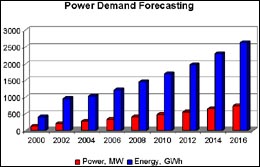
With regard to electricity generation planning,
the government envisions the establishment of
a gas power plant in Sihanoukville and hydropower
projects located in the western portion of Cambodia.
The government also plans to develop a national
grid linking the larger generating units to population
centres, starting initially in the southern portion
of the country (Phnom Penh to the Vietnam border,
Takeo, Kampot and Sihanoukville), and later expanding
to the northern region, including Banteay Mean
Chay, Siem Reap and Battambang. The government
has also initiated a rural electrification program
that includes the development of renewable energy
sources.
 Energy
Development Plan Energy
Development Plan |
As concerns the Rural Electrification Strategy
the Minister of Industry, Energy and Mines precises
that " The electricity development program
includes grid extension to the areas that are
close to an existing grid and the development
of stand-alone systems with diesel generators
for villages and small communities and the development
of renewable energy sources with projects like
the micro-hydro in the northeastern or western
part of the country, and the solar power energy".
The minister also explains how the creation of
the Rural Electrification Fund (REF) will "subsidize
one part of the rural electrification investment;
the other sources of financing are:
1) longer term loan from local commercial bank
designated by the World Bank and (2) self equity".
Plans for Cambodia's first independent power
production project, scheduled to provide another
60 megawatts of electrical power to the city,
are nearing completion.
According to the Cambodia Power Sector Strategy
(1999-2016) developed by the Ministry of Industry,
Mines, and Energy (MIME), annual electricity demand
in Cambodia is projected to rise from 522GWh in
1998 to 2,634 GWh in 2016. To meet this demand,
the government plans to develop $1 billion worth
of hydro, gas turbine thermal, and combined cycle
base load thermal generating plants in Phnom Penh,
Sihanoukville, Battambang, and other cities from
2000 to 2010. The Cambodian government also plans
to build a nation-wide transmission system during
the same period.
Though Power supply to the city of Phnom Penh
has improved dramatically since 1993, and approximately
50 megawatts of power were added to serve the
city during 1995 and 1996, the gap between the
needs and the energy supplied remains .The Master
Plan proposed that to satisfy demand in Phnom
Penh and these densely populated parts of Cambodia,
a major part of the capacity required be established
in Sihanoukville and capacity for peak demand
be established in Phnom Penh. It also proposed
that up to 30% (80MW) of demand be met through
Power Trade with Vietnam.
 Power
Sector Investment Plan Power
Sector Investment Plan |
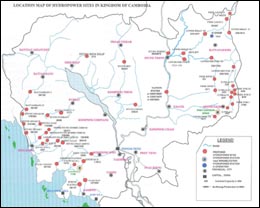
Indeed The implementation of the Power Sector
Strategy will be a very major undertaking for
Cambodia. It is estimated that total investment
requirements over the period 1999-2016 would total
USD1.2 to us$1.5 billion. For the first 5 years
of the Program (1999-2003), the investment required
is USD400 million, which represents over 10% of
total domestic investment and nearly 3% of GDP.
Concessional finance together with private sector
investment will need to be mobilized.
The Investment Plan comprises (i) the development
of a National Generation and Transmission Grid;
(ii) a Provincial Supplies Rehabilitation Program;
and (iii) a Rural Electrification Strategy and
Implementation Plan.
 Private
Sector Participation in the Electric Sector
Development Private
Sector Participation in the Electric Sector
Development |
The Government wishes to encourage private sector
participation in the development of the electricity
sector. A means of achieving this in rural areas
has already been discussed above.
In relation to private sector companies' participation
in providing power to supply the National Grid,
Phnom Penh and provincial towns, a policy is to
be developed to encourage private sector supply
of power at competitive prices. A World Bank sponsored
grant is used to develop guidelines on private
sector participation. It will include guidelines
for competitive tendering by private sector power
producers to supply EDC. As in other countries,
a Model Power Purchase Agreement will be used
for competitive tendering. Policies will also
clearly identify the taxation and investment incentives
that are available for investment in the power
sector.
|
 Major
Players in Independent Power Production Major
Players in Independent Power Production |
There are a number of proposed power plants in
Cambodia accounting for hundreds of millions.
They include 320MW and 180MW plants by Siemens
AG, a 12MW plant by Chinese company CETIC,
a 180MW project by Japanese company JICA, and
a 60MW plant by the US company Beacon Hill. Among
those completed and operational are:
Kirirom I
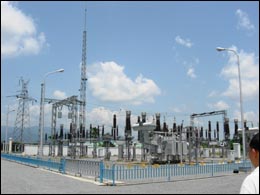
This is the first contract on a BOT basis realized
by the Chinese company CETIC
, in Cambodia. As his General Manager, Mr.
Xiaoming Ou, explains: "Kirirom I comprises
one power plant with two 6 MW turbine units, and
the dam which has been rebuilt. (…) a transmission
line of 115 Kv. with a length of 120 Km to connect
Kirirom with Phnom Penh". Although it was
the first time the company found itself engaged
in such project, the experience has been quite
positive and plans are on their way to start a
second project, Kirirom III, as Mr. Xiaoming Ou
said: "We have formally expressed our desire
to the MIME (Ministry of Industry, Mines &
Energy) to build Kirirom III on a BOT basis. We
are scheduled to start in July or August this
year". This is a slightly bigger project
30 Km. away from Kirirom I, with an 18 MW hydropower
plant. If this project works out as expected,
the Chinese company will most likely start into
even bigger projects in a country that is extremely
rich in water resources.
 Oil and
gas sector in Cambodia : "exploring to
fuel the economy" Oil and
gas sector in Cambodia : "exploring to
fuel the economy" |
Cambodia's natural resources, in particular,
the oil and gas sector has remained largely untapped
due to falling prices, internal conflicts and
territorial disputes with neighbouring Thailand.
For H.E. Sok An, Minister in
charge of the council of Ministers "
The CNPA sees the discovery and processing of
oil and gas products within Cambodia as a vital
step in accelerating the country's economic development".
At present, petroleum products for domestic and
industrial use are imported, at an ever-increasing
rate and at great expense, from Singapore, Vietnam
and Thailand
The total estimated reserves in terms of Gas
and Oil plus condensates is about 15TCF (Trillion
Cubic Feet) for the offshore and is located in
different acreages. It is also said that the most
viable and large reservoirs are in the disputed
waters in the Gulf of Siam - the Overlapping Claims
Areas and the inland reservoirs in the Tonle Sap
region.
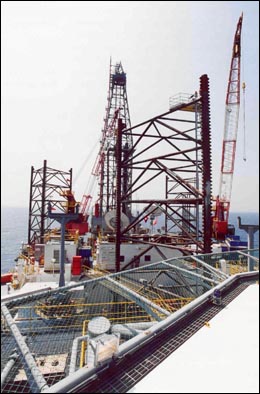
Along the Overlapping Claims Area, an area estimated
to stretch some 27,000 square kilometers and an
area said to be most viable for commercial exploitation
of oil and gas is currently under negotiations
with the Thai authorities for production sharing
and joint exploration rights. Past exploratory
wells drilled between late 1960s and 1974 when
at least three wells were drilled with mixed results
but said to be largely not commercially viable.
It was only in 1987 that surveys suggested the
existence of an offshore basin - the Khmer Trough,
which bears strong resemblance to the prolific
Patanni Trough and the Malay Basin Province. In
1994, exploration took off to a strong start with
the drilling of four wells again with mixed results
but left unexploited for commercial reasons and
then again in 1998 when Woodside carried out seismic
survey and a reassessment of all previous seismic
data. Woodside relinquished their rights in 1999
and 2000 respectively and the oil and gas activities
went silent again until 2002 when ChevronTexaco-MOECO
signed a production sharing agreement with the
Cambodian National Petroleum Authority in August
2002 and embarked on the drilling of two exploratory
wells in January this year.
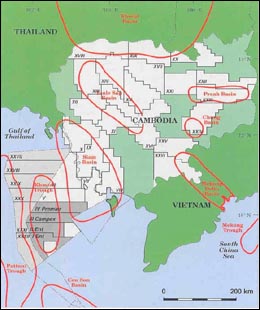
As the Director General of the CNPA, H.E. Te
Duong Tara explains: "(…) the CNPA would
be in charge of both aspects of the oil sector,
upstream and downstream. With upstream we mean
all activity starting from day one until you get
production and downstream from wellhead down to
the consumer. (…) we have been assigned a
huge task, and in order to accomplish this task,
we need investment and qualified human resources."
The CNPA is in the process of preparing an Energy
Master Plan to develop the whole energy sector.
The institution, has also drafted the Petroleum
Act that should have to be approved at the end
of this year. Concerning this Act, H.E. Te Duong
Tara said: "(…) the new law is going
to be very comprehensive. (…) I hope this
new law will accommodate everyone as it will be
more flexible and will give more incentive for
the investor to come in. Unlike before, the market
of oil and gas is open, so we have to be more
competitive compared to the neighboring countries
Vietnam and Thailand."
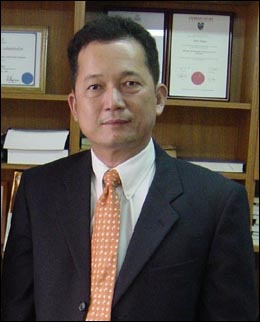
While the oil industry gets on its way, other
companies have known how to establish itself in
the country and provide the current needs by importing
oil. Although several multinational and regional
companies are present in the Cambodian market,
the largest company is Sokimex
Group. Sokimex
( started as a trading firm and has grown to a
giant, the biggest company in Cambodia with almost
50% of the oil distribution and businesses in
other areas like industry and tourism. As his
Vice-Chairman, Oknha Sorn Sokna, explains: "Sokimex
is indeed the first petroleum company of the country
but it is also involved in several other businesses"
 MINING
SECTOR MINING
SECTOR |
Cambodia is known worldwide for its rubies, but
there are more mineral resources in the Cambodian
soils proven potential exists for: sapphires,
alluvial, gold, alluvial cassiterite, silica,
manganese, slate, peat, pagodite, phosphate, granite,
limestone, sand, gravel, clay, bauxite, zinc and
copper.
The legal environment for business in the mining
sector is deficient. The Cabinet Council of Ministers
discussed an update of the mining code in August
1995 but no details of possible changes are yet
available. It is envisaged that the mining code
will be complemented by a sub-decree on mining,
which will provide a detailed legal framework
governing the sector.
Government Mineral Exploration Policy: Companies
are offered, during the 1st phase, two to six
years to conduct exploration and a feasibility
study in a designated area. MIME will assist with
technical recommendations and the Cambodia
Development Council (CDC) grants an exploration
license to interested investors.
During the second phase, if exploration is successful,
companies are required to present a master project
plan. CDC grants a mining license to companies.
Royalties and surface rentals are levied on mineral
extraction. When production is profitable, companies
are required to pay income taxes, in addition
to royalties and surface rentals. MIME encourages
two forms of contracts: a production sharing agreement
with a low tax rate, or a concession with a high
tax rate.
|

